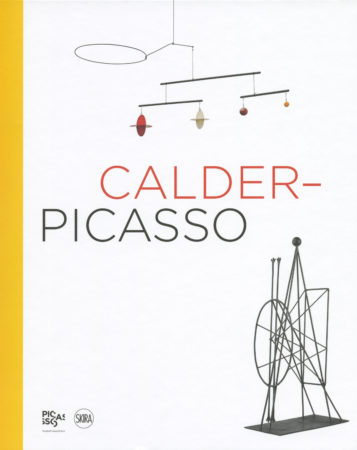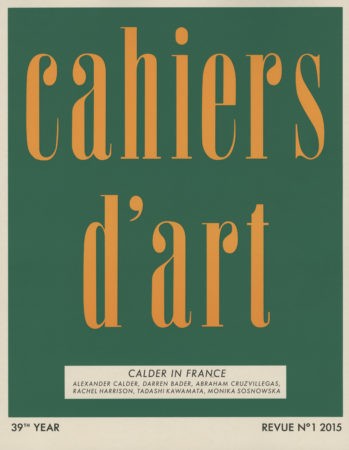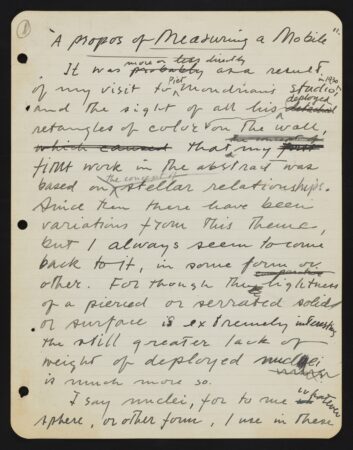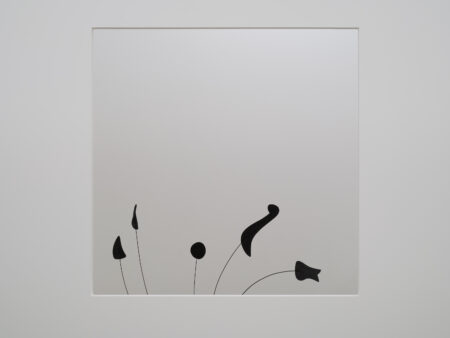Filter 358 results
Fall 1926
ChronologyCalder begins creating Cirque Calder, a complex and unique body of art. Fashioned from wire, fabric, leather, rubber, cork, and other materials, Cirque Calder is designed to be performed for an audience by Calder. It develops into a multi-act articulated series of mechanized sculpture in miniature scale, a distillation of the natural circus. Calder is able to travel with his easily transportable circus and hold performances on both continents. Over the next five years, Calder continues to develop and expand this work of performance art to fill five large suitcases.
27 April–9 May 1931
ChronologyCalder’s abstract work is presented for the first time in the exhibition “Alexandre Calder: Volumes–Vecteurs–Densités / Dessins–Portraits,” at Galerie Percier, Paris. Léger writes in the introduction to the catalogue:
Eric Satie illustrated byCALDER
Why not?
“It’s serious without seeming to be.”
Neoplastician from the start, he believed in the absolute of two colored rectangles. . . .
His need for fantasy broke the connection; he started to “play” with his materials: wood, plaster, iron, wire, especiallly iron wire. . . .a time both picturesque and spirited. . . .
. . . .A reaction; the wire stretches, becomes rigid, geometrical—pure plastic—it is the present era—an anti-Romantic impulse dominated by the problem of equilibrium.
Looking at these new works—transparent, objective, exact—I think of Satie, Mondrian, Marcel Duchamp, Brancusi, Arp—those unchallenged masters of unexpressed and silent beauty. Calder is of the same line.
He is 100% American.
Satie and Duchamp are 100% French.
And yet, we meet?
8–18 July 1957
ChronologyWhile visiting Ritou Nitzschke and André Bac in La Roche Jaune, Brittany, the Calders buy an old customs house, Le Palud, located at the mouth of the Tréguier River. A few times a year, at high tide, the house site becomes an island.
1912
ChronologyThe Calders move to Spuyten Duyvil, New York. The cellar becomes Calder’s workshop. Calder and Peggy attend Yonkers High School. Stirling rents a studio in New York City on 51 West Tenth Street.
June 1913
ChronologyThe Calders move to San Francisco. Calder has a workshop in the cellar and attends Lowell High School.
Spring 1915
ChronologyStirling and Nanette move to Berkeley to be near Stirling’s next commission, the Oakland Auditorium. Calder stays with the architect Walter Bliss and his wife to graduate from Lowell High School.

Musée Picasso, Paris. Calder-Picasso. Exhibition catalogue. 2019.
Chus Martinez, No Feeling Is FinalPace Gallery, Los Angeles. Calder/Tuttle:Tentative. 21 January–25 February 2023.

“Calder in France.” Cahiers d’Art, no. 1 (2015). Edited by Alexander S. C. Rower.
Agnès Varda in conversation with Joan Simon
Calder, Alexander. “À Propos of Measuring a Mobile.” Manuscript, 1943. Agnes Rindge Claflin papers concerning Alexander Calder, 1936-circa 1970s. Archives of American Art, Smithsonian Institution.
Featured Text
